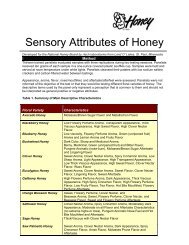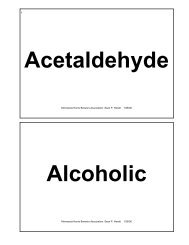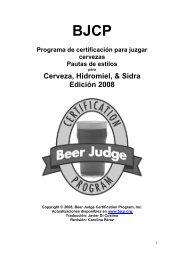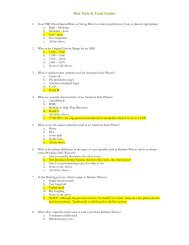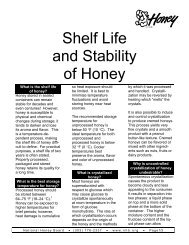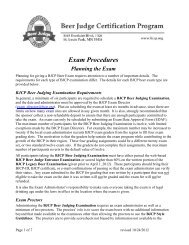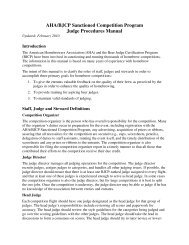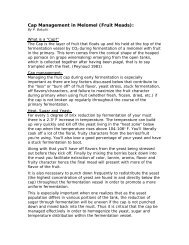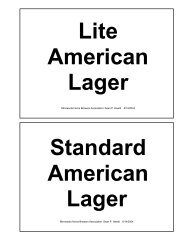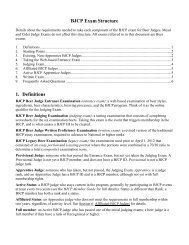Create successful ePaper yourself
Turn your PDF publications into a flip-book with our unique Google optimized e-Paper software.
PresentationAs for the presentation of beers, two methods are common, each with positive and negative points. Onemethod of presentation permits judges open and pour the beer into their own cups. A second method ofpresentation requires stewards to pour beer into pitchers, and the beer is transferred from the pitcherinto judges’ cups. When judges are allowed to pour their own beers, there is some danger that movingbottles to the evaluation table will stir up yeast and that judges’ opinions of a beer’s quality will beinfluenced by the appearance of the bottles that it comes in. On the other hand, when judges transferbeer from a pitcher, it is more difficult to capture many of the fleeting aromas that might dissipatebetween the time the bottle is opened and the time that judges are presented with the beer. Anotherproblem with using pitchers is that it is more difficult to temporarily store beer samples so that judgescan taste them again at a later time.The Judging ProcessDecision StrategiesThere are two general decision making strategies that judges use when evaluating a beer. In a top-downdecision making strategy, the judge forms an overall impression about the quality of the beer, decideswhat overall score to assign that beer, and deducts points for each deficient characteristic of the beerbased on the overall impression. The problem with this top-down approach to beer evaluation is that itis difficult to ensure that the points allocated to each subcategory (e.g., aroma, appearance, flavor,body) agree with the comments that were made about that feature of the beer. In a bottom-up decisionmaking strategy, the judge scores each subcategory of the beer, deducting points for each deficientcharacteristic. The overall score is determined by summing the points for each subcategory. Theproblem with this bottom-up approach to beer evaluation is that it easy to arrive at an overall score forthe beer that does not agree with the overall impression of the beer. In short, judges who use a topdownapproach to judging beers may “miss the trees for the forest,” while judges who use a bottom-upapproach to judging beers may “miss the forest for the trees.”Most judges use a combination of these two extremes. Regardless of which approach seems morecomfortable to an individual beer judge, there are several general guidelines that judges should followwhen assigning scores to beers. In the current <strong>BJCP</strong> scoring systems, each beer is evaluated on a 50-point scale, allocating 12 points for Aroma, 3 for Appearance, 20 for Flavor, 5 for Mouthfeel and 10 forOverall Impression. This scoresheet can be found on the <strong>BJCP</strong> website. In addition, there are slidingscales on the bottom right hand corner for rating the stylistic accuracy, technical merit and intangibles ofeach beer.Overall scores should conform to the descriptions given at the bottom of each scoresheet. Excellentratings (38-44) should be assigned to beers that are excellent representations of the style. Very Goodratings (30-37) should be assigned to good representations of the style that have only minor flaws.Good ratings (21-29) should be assigned to good representations of the style that have significant flaws.Drinkable ratings (14-20) should be assigned to beers that do not adequately represent the style becauseof serious flaws. A problem rating (13 or lower) is typically assigned to beers that contain flaws that areso serious that the beer is rendered undrinkable. The scoresheet reserves the 45-50 range foroutstanding beers that are truly world-class.In general, the best beers at a competition should be assigned scores in the 40+ range, with realevaluations of the beer identifying some characteristics of the beer that make it non-perfect. A beer11



